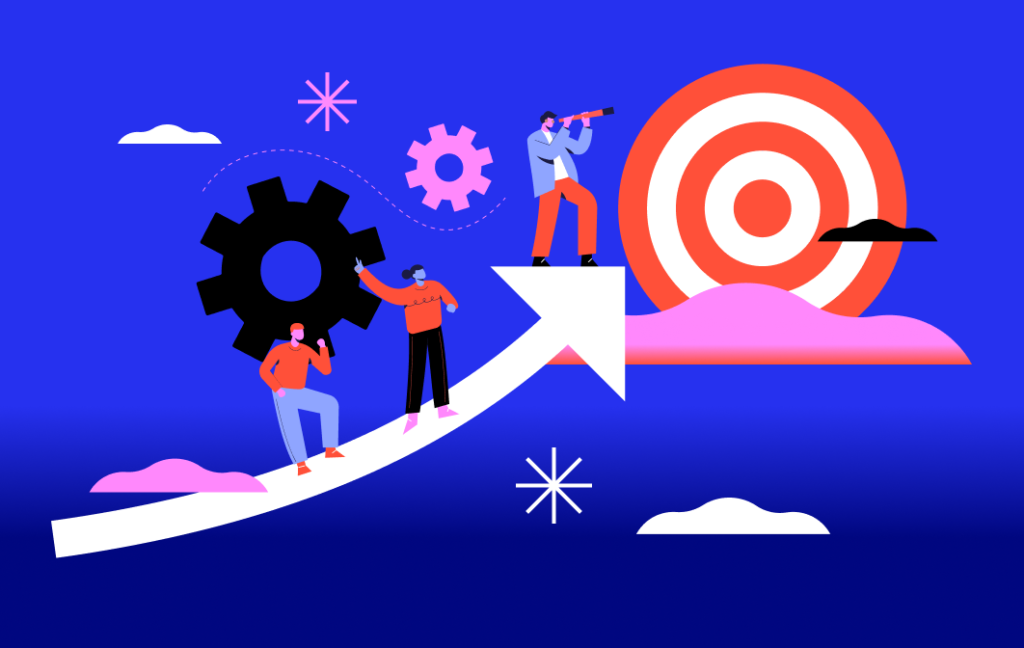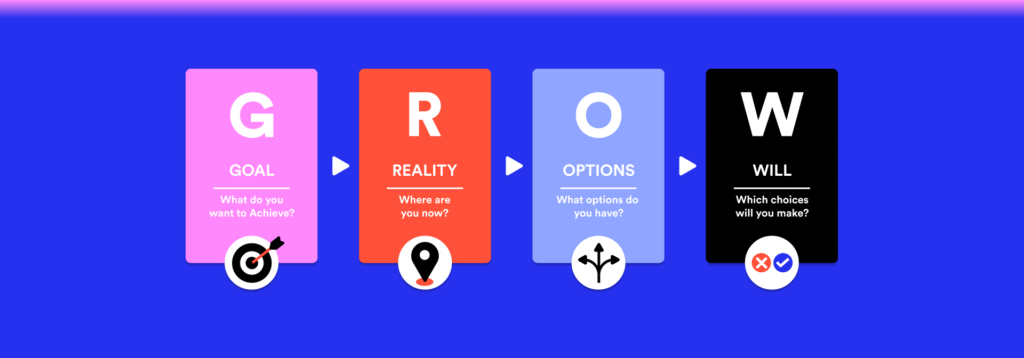Great leaders prioritize their employees’ professional growth and development because they reckon their leadership success is tied to that of their subordinates. The GROW Model of mentoring simplifies this responsibility for leaders, providing a simple yet comprehensive framework for employee development.
GROW was influenced by a method (the Inner Game) developed by a tennis coach. Timothy Gallwey noticed that telling tennis players what they should be doing did not bring about lasting change. A typical example is players who do not keep their eyes on the ball. Most of the coaches might give instructions such as: “Keep your eye on the ball” to correct this. The problem with this sort of instruction is that a player will follow it for a short while but cannot keep it in mind in the long term. So one day, instead of giving an instruction, Gallwey asked players to say “bounce” out loud when the ball bounced and “hit” out loud when they hit the ball (see the classic video).
The result was much more positive. The players started to improve without much effort because they were keeping their eyes on the ball. They did not have a voice in their heads saying, “I must keep my eye on the ball.” Instead, they were playing a much more simple game while they were playing tennis: Bounce-Hit. After Gallwey saw how he could improve the play, he stopped giving instructions and started asking questions that would help players discover what worked and what needed to change.
The GROW method is similar. As an example, the first stage in the learning process would be setting a target that a player wants to achieve. If a player wanted to improve first serve, Gallwey would ask how many first serves out of ten they would like to get in (the Goal). Second, Gallwey would ask the player to serve ten balls and seeing how many first serves went in (the Reality).
Gallwey would then ask questions to raise awareness, such as “What do you notice you are doing differently when the ball goes in or out?” It would help players discover their mental and physical status when the serve went in or out (Obstacles and Options). Therefore, they learned what had to change to meet their serving targets, and they had a clear Way Forward.
The GROW and the Inner Game methods suggested that many individuals were struggling to achieve goals because they were not learning from experience and were not aware of the available knowledge that would help them.
The GROW Model refers to a coaching system based on four key propositions:
G – Goal setting
R – Reality check
O – Options for solving problems
W – Will to put plans into action
It was first introduced by business coaches Graham Alexander, Alan Fine, and Sir John Whitmore in the 1980s. Since then, it’s become one of the most widely adopted coaching models in the world.
One of the reasons behinds its wild popularity is its adaptability. GROW can be mutated or tweaked to fit into the unique contexts of various businesses. This has helped uncounted businesses across the board to adopt GROW successfully, compared to many other coaching models.
The Powerful Effects of GROW Coaching
GROW is a powerful coaching model because it takes account of fine details – the daily activities at the office, the regular conversations on the sales floor, etc. It helps you motivate your employees to set realistic goals and take their best shot at them. GROW makes it easy to guide your employees through every step of a project or business process, from setting goals to analyzing challenges, finding solutions, and swinging into action.
With GROW, you can maximize your employees’ potentials by equipping them with the knowledge and skills they need for enhanced productivity, effective communication, improved interpersonal skills, and greater self-confidence and morale.
The best part is that you can adopt GROW using four easy steps, regardless of the nature of your business.
How to Adopt GROW Mentoring/Coaching in 4 Simple Steps
Step 1: G – Goal Setting
One of the most reliable techniques for setting goals is known as SMART – Specific, Attainable, Realistic, Timely. This simply means that your goals must be specific, within the reach of your current capacities, and achievable within a specific timeframe.
When assessing your employee’s ability to meet desired goals, you should consider not only their skills and proficiencies but their level of motivation as well. If they’re not motivated to do their best, then the goal is a mismatch for them. To deal with this part, you need to, first, establish the benefits of the goal to the employee and the business. Your employees will most likely come onboard your plan if they believe the plan will be of benefit to them and the business.
In general, you should consider the following questions while taking this step:
- What are the desired results of this coaching session?
- When do you expect to achieve this?
- How can you assess your achievements?
- How will it change things?
- What happens if the goal is not achieved?
Step 2: R – Reality Check
At this stage, objectivity and keen attention to details become more imperative. This is where you need to capture every possible challenge your employees, clients, or students might face in pursuit of the set goals.
The facts and inputs you gather from this stage will help you create a meticulous individual development plan (IDP) framework for action. What you need to do is simply compare the set goals with the current situation, and then plot a route from the current to the desired situation.
You need to determine the values and resources that’ll help you scale the present limitations, from thoughts/feelings to actions and material resources.
Here’s a reality checklist for this stage of development conversations:
- What’s the reason behind the current situation?
- Have there been any unsuccessful attempts to solve the situation?
- What’s preventing you from trying something different?
- Who’re those involved?
- How’s the new plan going today?
- What’s working now and what’s not?

Step 3: O – Options
This is where you get to consider the fine details of your plans. What feasible options are available for you to explore? What specific human and material resources do you need? Does the plan require different attitudes and skills? Do you need a different decision-making process? This is also where you get to allocate responsibilities during development 1:1s.
You can begin this stage with a brain dump – pouring out every idea that comes to mind. You can then sit over the list, assessing the pros and cons of each option. With this holistic, meticulous approach, you can gather insights and inputs for creating not just one but multiple plans with alternative options for professional development.
Ask these questions:
- What has worked well before and what hasn’t?
- What are the alternative ways?
- What are the benefits/costs of each option?
- What options can you deploy immediately?
- How do you and your employees feel about this option?
Step 4: W – Will
It’s not just enough to establish a goal and an action plan for achieving it. This is where you need to put measures in place to ensure that the plan goes into motion. You need to set timeframes and setup a system to follow up on and oversee the activities of everyone involved. You also need to ensure that your employees are fully equipped to take on both foreseen and unforeseen challenges. You should ensure that everyone has access to adequate emotional, intellectual, and technical support.
Here some are questions to consider:
- What can you do at the moment?
- When will you start?
- What will take to get you fully motivated
- What type of support do you need?
- What’s your level of commitment to the action plan?
Put Your GROW Coaching Plan to Work
These questions and considerations can help raise the levels of productivity and employee morale in just about any organization. With GROW coaching, all you need to do is set SMART goals that everyone is motivated to achieve, carry out an objective assessment of the reality on the ground, assess the available options for achieving these goals, and set up an effective follow-up and support system to ensure the plan goes into motion.
If you want to learn more about employee development, you can check out our blog posts here.

